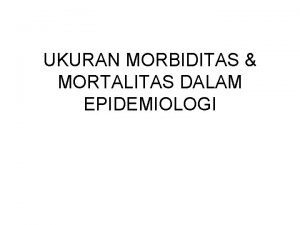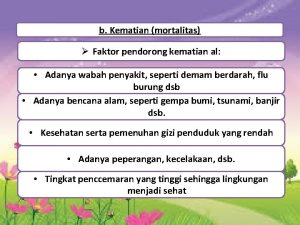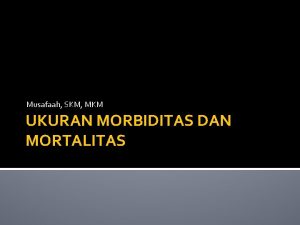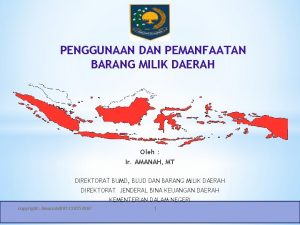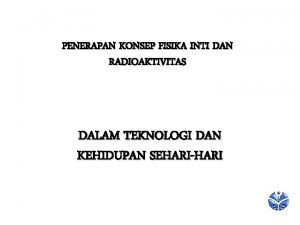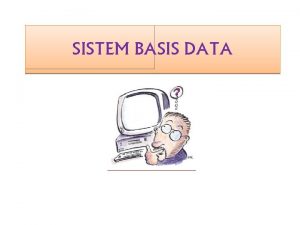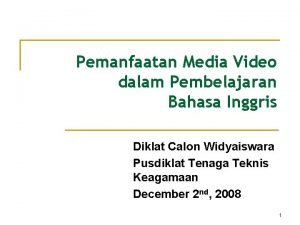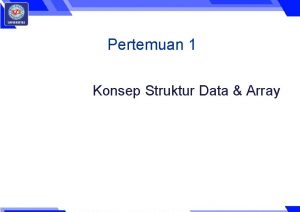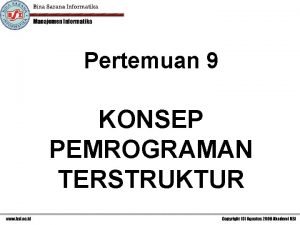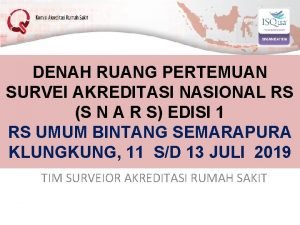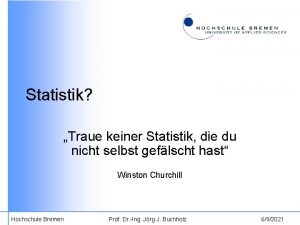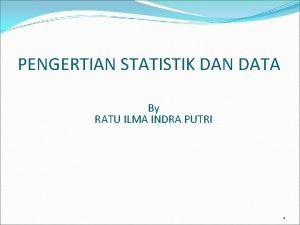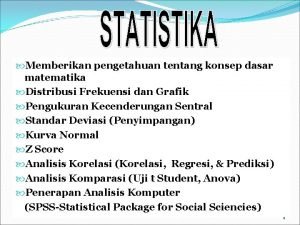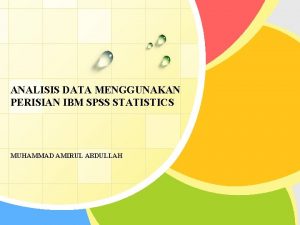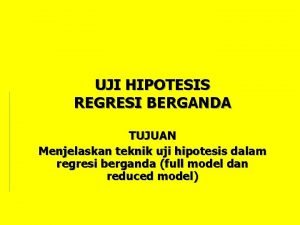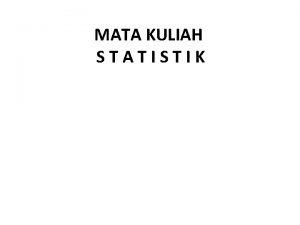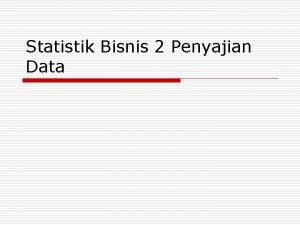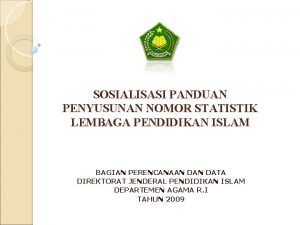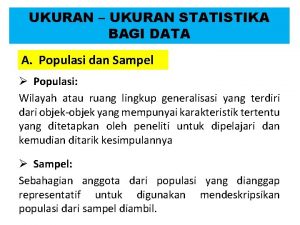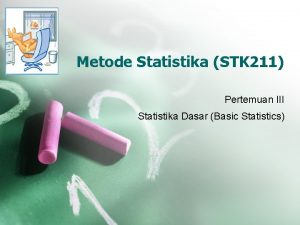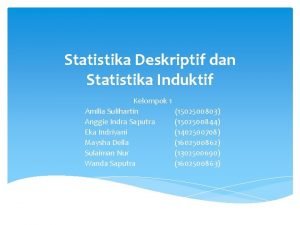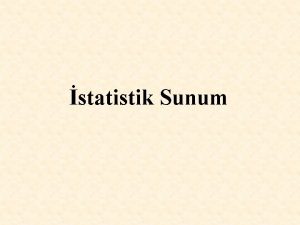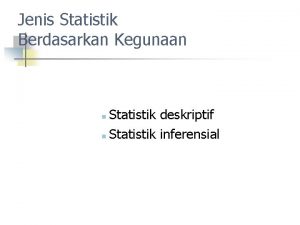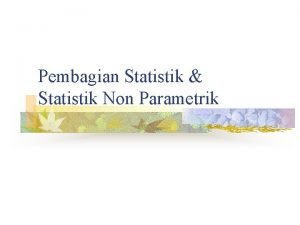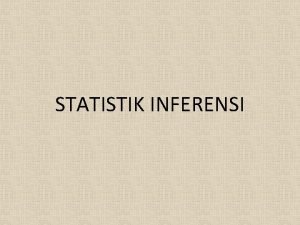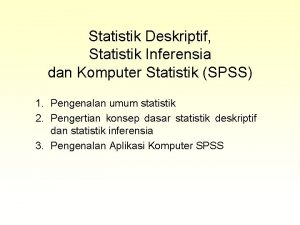Sejarah Pemanfaatan Statistik Mortalitas Pertemuan 2 dr Mayang
































































- Slides: 64

Sejarah Pemanfaatan Statistik Mortalitas Pertemuan 2 dr. Mayang Anggraini Prodi RMIK, Fakultas Ilmu-ilmu Kesehatan

KEMAMPUAN AKHIR YANG DIHARAPKAN 1. Mahasiswa memahami dan menjelaskan Sejarah Pemanfaatan Statistik Mortalitas dengan tepat dan benar

Sekilas Sejarah Pemanfaatan Statistik Mortalitas dalam Era Manajemen Informasi Kesehatan Masyarakat Disusun oleh dr Mayang Anggraini Naga FIKES- RM-IK U-EU (Revisi 2016) 3

Pre-Computer Era Public Health Information Management Systems 4

Reading Pre-Computer Era Public Health Information Management Systems Their Roots in Antiquity: The first phase: reflected public health observations according to individual experiens. (Fase I: merefleksi berbagai observasi sesuai pengalaman pribadi) 5

(Cont. -1) The seconds phase: reflected a movement beyond observation to analysis of the root causes of public health disturbances (Fase II: merefleksi suatu gerakan di luar obervasi untuk menganalisis akar penyebab gangguan kesehatan masyarakat) 6

(Cont. -2) The third phase: leading to the rise of modern public health informatics, featured advanced methods of data collection and analysis in public health practice. (Fase III: mengarah ke meningkatnya informatik kesehatan masyarakat, gambaran metode yang lebih maju terkait pengkoleksian data dan penganalisisannya pada praktek kesehatan masyarakat) 7

The first phase: The Age of Observation by the great physicians of their times in: - China Egypt, India, Greece Rome Provided the foundation for preventive and curative practice of vaccination is known to have existed as early as the first century in China. 8

The first phase (cont. -1) The most famous of the pre-computer era public health practitioners was Hippoctrates, whose teaching reflects the way early health practitioners used: Observation to understand the relationship of health to living conditions. The observation of such practitioners led to the Developement and Implementation of Public Health Interventions. 9

The first phase (cont. -2) • For example: The Importance of Sanitation was discovered early in the rise of civilization. Eventually, the age of observation in public health gave way to the age of ANALYSIS. 10

The Second Phase: The Age of Analysis The fall of Roman Empire, during the late 400 s of the Common Era marked the end of an exchange of scientific learning between hemispheres. For the next 1. 000 years, social and political forces led to the Isolation of Europe from many of the Cultural and Scientific Developments in Africa, Asia, and other parts of the world. 11

The Second Phase (Cont. -1): Much of the writtings and the knowledge acquired during the Observation Era was lost. However, the Arab cultures of the Mediterranean preserved it to some extent and Reintroduced it to the peoples of Europe during Trade and the Moorish occupation. 12

The Second Phase (Cont. -2): The European rediscovery of the Americas the subsequent colonization resulted in a Eurocentric New World scientific community. and The scientific and health systems that developed in the colonial and 19 th century United State was dependent on the state of the art in Europe. 13

The Second Phase (Cont. -3): Certain events occuring during the Age of Analysis had profound implications for public health practice. These event indcluded: - The breakout of bubonic plague (A 20. 0) in Messina, Sicily in October 1347, spread of the deadly disease to other parts of Europe resulting in social upheaval. 14

The Second Phase (Cont. -4): General recognition of the importance of a healthy population to the national wealth and power. The philosopher William Perry, who invented the term political arithmatic, argued that the analysis of data could throw light on matters of national interest and policy: 15

He suggested that the Control of Communicable Disease and the Reduction of infant mortality would contribute the most to Preventing Impairment of the population. He was one of the first to calculate the economic loss caused by disease. 16

The Second Phase (Cont. -5): The great explosion in knowledge and learning accompanying the Renaissance in Europe. An important resulting enhancement to the evolution of public health practice was Adoption of the Scientific Method, a systematic approach that laid the foundation for: Collection and Analysis of Health-Related Data. 17

The Second Phase (Cont. -6): The establishment of basic principles for analysis of data and determination of data reliability by John Graunt, who in 1662 analysed over 30 years of Vital Statistics and Social Data. Graunt’s work demonstrated a method of developing useful information through the Careful and Logical Interpretation of Imperfect Data. 18

The Second Phase (Cont. -7): The work of Huygens in developing a precursor to mortality tables, work that was based on the findings of Graunt and his own earlier work on probability. Edmond Haley’s merging of these concepts and his development of: the First Mortality Tables to predict Life Expectancy in 1693. 19

The Second Phase (Cont. -8): Haley’s merger of data collection and probabilitic analysis of public health data. The contribution of scientists such as Laplace and Bernoulli in the application of mathematical principles to public health issues, work that set the stage for the major advance in data and information management that led to the development of the Modern Epidemiological Approach. 20

The Third Phase: The Root of Modern Public Health Informatics During 19 th century and the first half of the 20 th century, development in both England United States created the necessity for advanced methodes of Data Collection and Analysis in Public Health Practice. 21

Cholera Outbreak 19 th centruy, England: Cholera epidemics led to major changes in the practice of public health. Cholera epidemics of 1831, 1832 highlighted the role that neglected sanitation among the poor had in imperiling (membahayakan) the HEALTH OF ALL. 22

The Root of. . (Cont. -1) The New Poor Law was passed, and the Poor Law Commision was formed in 1834 in response. Dr. Erwin Chadwick was appointed the secretary of the commision and became one of the leading forces in the SANITATION MOVEMENT. He proposed the formation of the Bureau of Medical Statistics in the poor Law Office. 23

The Root of. . (Cont. -2) Under his leadership, Dr. William Farr began to use data that became available under the 1836 Births and Deaths Act. Chadwick proposed that this act would lead to: Registration of the Causes of Disease with a view to devising remedies or mean of prevention. 24

The Root of. . (Cont. -3) A vast amount of data was collected under these two acts. Analysis of these data by Farr led to the understanding of the: Role of Sanitation and Health. Farr’s analysis represented one of the earliest examples of the presentation of a plausible epidemiologist theory to fit known facts and collected data. 25

Florence Nightingale 1859, Florence Nightingale, working with William Farr, confirmed the connection between sanitation and mortality by studying the horrendous death rate in the Brittish Army in the Crimea. Not only did these public health workers compare death rates in the army for non-combat-related illness to a reference population, but they also published one of the first uses of graphics to present Public Health Data. 26

Dalam “Notes on a Hospital” Florence Nightingale memaparkan sulitnya memperoleh Rekam Medis yang segera dapat menghasilkan informasi untuk tujuan perban-dingan, yang apabila ini dapat diperoleh akan dapat menjelaskan berapa: - uang yang telah dibayarkan, - jenis sumberdaya apa yang telah dikonsumsi, dan 27

- apakah jumlah uang yang telah dikeluarkan untuk semua yang kualitasnya cukup baik? DRGs-Case. Mix. (INA-DRG INA-CBGs) 28

(Cont. -2) At this time, Adolphe Quetelet consolidated current statistical developments and applied them to the analysis of community health data compiled by observation and enumeration. (merinci satu-persatu) He noted that variation was a characteristic of biological and social phenomenon and that such variation occured around a mean of a number of observation. 29

(Cont. -3) Further, he demonstrated that the distribution of observation around a mean corresponded to the distribution of probabilitis on a probability curve. This work helped form the foundation of biostatistics as applied to the Health of the Public. 30

1854 • Cholera again struck London. Dr. John Snow conducted an investigation of the outbreak in the Soho section of London. He carefully mapped the location of each of the victims. The mapping revealed a pattern centered on the Broad Street pump. He then proceeded to convince local authorities to remove the handle from the pump, thereby stopping the outbreak. 31

Dr. John Snow. . . (Cont. -1) He continued the analysis of the outbreak and was able to associate the location of the water intake that supplied the Broad Street pump with other water companies and sewage outflows in the Thames River. 32

Dr. John Snow. . . (Cont. -2) His work led to future regulation of water supply intakes. The methodology that he used has become the foundation of all modern epidemiological investigations of a disease outbreak. He also was one of the first to use a rudimentary manual graphical information system (GIS) – a map and a pencil 33

Dr. John Snow (Cont. 3) The application of scientific learning began to have a positive impacrt on the health of the English population. In 1866, it was noted that cities without a system for monitoring and combating cholera fared far worse in the epidemic of that year. 34

Mortality Review • Review of Mortality (death) is an important outcome indicator. • Establishing a meaningful evaluation of mortality is essential in the analysis of: ongoing outcome and process improvement. 35

Hospital Death Rates • The hospital death rate is based on the number of patients discharge, alive or dead, from the hospital. Death are considered discharged because they are the end point of a period of hospitalization. • Newborns are not counted separately from adults and children. 36

Neonatal Mortality Rates • The neonatal mortality rate can be used as an indirect measure of the: - quality of prenatal care and/or - the mother’s pre-natal behavior (for example: alcohol, drug, or tobacco use). • The neonatal period is the period from birth up to, but not including, 28 days of age. 37

(Cont. -) In the formula for calculating the neonatal mortality rate: and - the numerator is the number of deaths of infants under 28 days of age during a given time period the denominator is the total number of live births during the same time period. 38

Post-neonatal Mortality Rate The postneonatal moratlity rate is often used as an indicator of the quality of the home or community environment of infants. The postneonatal period is the period from 28 days up to but not including one year of age. 39

(Cont. -) In the formula for calculating the postnatal mortality rate, the numerator is the number of death among infants from age 28 days up to but not including one year during a given period and the denominator is the total number of live birth less the number of neonatal deaths during the same time period. 40

Infant Mortality Rate The infant mortality rate is the summary of the neonatal and postnatal mortality rates. In the formula for calculating the infant mortality rate, the numerator is the number of deaths among infants under one year of age and the denominator is the number of live births during the same period. 41

(Cont. -) The infant mortality rates is the most commonly used measure for comparing health status among nations. All the rates are expressed in terms of the number of deaths per 1. 000. 42

Death (Mortality) Rates • Other measure of mortality with which the HIM profesional should be familiar include the: crude death rate, the cause specific death rate, the case fatality rate, the proportionate mortality rate and the maternal death rate. Di manajemen RM kita kenal: net death rate 43

Crude Death Rate • Crude death rate is a measure of the actual or observed mortality in a given population. • Crude death rate apply to a population without regard to caracteristic such as age, race, and sex. • They measure the proportion of the population that has died during a given period of time (usually one year) or the number of deaths in a community per 1. 000 for a given periode of time. 44

Cause-Specific Death Rate • The cause-specific death rate is the rate of death due to a specified cause. It may be calculated for an entire population or for any age, sex, or race. • In the formula, the numerator is the number of death due to a specified cause for a given time period and the denominator is the estimated population for the same time period. 45

Case Fatality Rate • The case fatality rate measure the probability of death among the diagnosed cases of a disease, most often acute illness. • In the formula for calculating the case fatality rate, the numerator is the number of death due to a specific disease that occurred during a specific time period and the denominator is the number of diagnosed cases during the same period. The higher the case fatality rate, the more virulent the infection. 46

Proportionate Mortality Ratio • The proportionate mortality ratio (PMR) is a measure of mortality due to a specific cause for a specific time period. • In the formula for calculating the PMR, the numerator is the number of deaths due to a specific disease for a specific time period and the denominator is the number of deaths from all causes for the same time period. 47

Maternal Mortality Rate • The maternal mortality rate measures the death associated with pregnancy for a specific community for a specific period of time. It is calculated only for deaths that are directly related to pregnancy. • Because the number of deaths per 100. 000 live maternal mortality is very small, it is usually expressed birth. 48

MATERNAL MORTALITY (Cont. -) • In the formula for calculating the maternal mortality rate, the numerator is the number of deaths attributed to cause related to pregnancy during a specific time period for a given community, and the denominator is the number of live births reported during the same time period for the same community. 49

Outcomes and Effectiveness Research in Healthcare The major objective of outcome and effectiveness research (OER) is to understand : The end results (outcomes) of particular healthcare practices and interventions. 50

Outcome (Cont. -1) Examples of outcomes include: the ability of a patient to function quality of life patient satisfaction mortality. by linking the care that patients recieve to the outcomes they experience, OER (outcome and effectiveness research) has become the key to developing better ways to monitor and improve the Quality of Care. 51

Outcome. . . (Cont. -2) • The history of outcomes research can be traced back to the 1860 s when Florence Nightingale laid the foundation for collecting and evaluating hospital statistics. • Hospital mortality rates were the basic measure used for evaluating patient outcomes. • The major finding was that mortality rates varied significantly from hospital to hospital. 52

Landmarks in the Development of Outcomes Research - The Felxner Report (1910), The Codman studie (1914) The esteblishment of hospital standards by the American College of Surgeons (1913) and The founding of the Joint Commission of Accreditation of Hospital (1952) (JCAH) are landmarks in the development of outcomes research. • More recently, the passage of Medicare (1965) and subsequent legislation accelerated interest in outcome research. 53

Outcome Movement • The current outcome movement gained momentum in the 1980 s when the PPS (Prospective Payment System) for Medicare (USA) inpatient care was implemented. • The public and policy makers were concerned that Medicare patients were being forced out of hospitals because “their DRG had run out”. • The fear was that patients were being discharged based on their LOS rather than when they were clinically ready for discharge. 54

Di USA • William Roper (HCFA CMS) administrator in 1986, promoted the use of Medicare database to monitor the quality of care through measurement of: mortality rates readmission rates other adverse outcomes. (HCFA = Health Care Financing Administration) (CMS = Centers for Medicare & Mediaid Services) 55

AHRQ (Agency for Health Care Research and Quality Mission: - to support research designed - to improve the outcomes and quality of healthcare. - reduce its cost - address patient safety & medical errors - broaden access to effective services. The research sponsored by the AHRQ provides information that helps people make better decisions about healthcare. 56

The Goal & Research Priorities of the AHRQ include: - Supporting improvement in health outcomes Strengthening quality measurement and improvement Identifying strategies to improve access, foster appropriate use Reduce unnecessary expenditures. 57

The Analysis Tool (HCUP) • HCUP (Health-care Cost and Utilization Project) is a database system for: research policy analysis quality measurement and improvement. 58

The Analysis Tool (HCUP) (Cont. -1) It contains some Web-based tools that can be used to identify track analyze and compare trends in hospital care at the national, regional and state levels. 59

The Analysis Tool (HCUP) (Cont. -2) The component of the HCUP is the HCUP Quality Indicators This is a set of clinical performance measure developed as a quick and easy-to-use screen-ing tool for use with administrative database. The indicators span three dimensions of care: - Potentially avoidable adverse hospital outcomes - Potentially inappropriate utilization of hospital procedures - Potentially avoidable hospital admissions. 60

Outcomes & Effectiveness Research Strategies • There is no standard method for conducting outcomes research at the institutional level or any level. • Donabedian (1966) proposed the first model for evaluating patient outcomes. His model focused on measuring the: structure, - process, and - outcomes of medical care. 61

Outcomes & Effectiveness. . . (Cont. -1) Structue: the setting in which the healthcare is provided and the resources available to provide it. Process: the extent to which professional perform according to accepted standards. Process is a set of activities that take place between providers. 62

Outcomes & Effectiveness. . . (Cont. -2) • Outcomes: include changes in the patient’s condition, quality of life, and level of satisfaction. Other models used for the study of outcomes includes: the disease model and the health and wellness model. 63

Outcomes & Effectiveness. . . (Cont. -3) Epidemiologicl approaches are often used to study outcomes. In the hospital setting, the MEDICAL RECORD often serves as the Data Source for Outcome Studies. 64
 Itik gembo gembo maksud
Itik gembo gembo maksud Mayang g03
Mayang g03 Pengertian case fatality rate
Pengertian case fatality rate Contoho
Contoho Faktor pendukung natalitas
Faktor pendukung natalitas Rlcraft mortalitas
Rlcraft mortalitas Faktor penghambat dan pendorong kematian
Faktor penghambat dan pendorong kematian Crude death rate adalah
Crude death rate adalah Pemanfaatan barang milik daerah
Pemanfaatan barang milik daerah Pemanfaatan stack
Pemanfaatan stack Tujuan pemanfaatan basis data
Tujuan pemanfaatan basis data Pemanfaatan kelas maya
Pemanfaatan kelas maya Peta konsep inti atom
Peta konsep inti atom Pemanfaatan stack
Pemanfaatan stack Pemanfaatan prinsip-prinsip ilmiah
Pemanfaatan prinsip-prinsip ilmiah Tujuan sistem basis data
Tujuan sistem basis data Jelaskan yang dimaksud dengan kenampakan alam
Jelaskan yang dimaksud dengan kenampakan alam Peta konsep pengelolaan sumber daya alam indonesia
Peta konsep pengelolaan sumber daya alam indonesia Pola pemanfaatan media pembelajaran
Pola pemanfaatan media pembelajaran Peta persebaran keragaman budaya di indonesia
Peta persebaran keragaman budaya di indonesia Logo pertemuan
Logo pertemuan Tester
Tester Maksud dari perintah program antrian.tail == max-1, adalah
Maksud dari perintah program antrian.tail == max-1, adalah Definition
Definition Pengertian struktur data array
Pengertian struktur data array Kata tugas
Kata tugas Penawaran elastis uniter terjadi jika
Penawaran elastis uniter terjadi jika Spk latihan pertemuan 6
Spk latihan pertemuan 6 Pertemuan 9
Pertemuan 9 Contoh pendekatan aksi sosial
Contoh pendekatan aksi sosial Sell adalah pertemuan antara
Sell adalah pertemuan antara Creat by
Creat by Pengertian etiket
Pengertian etiket Sel adalah pertemuan antara titik-titik dan titik-titik
Sel adalah pertemuan antara titik-titik dan titik-titik Pertemuan multikultural
Pertemuan multikultural Filosofi pertemuan
Filosofi pertemuan Pada pertemuan kali ini kita
Pada pertemuan kali ini kita Pertemuan awal pkh adalah
Pertemuan awal pkh adalah Tugas pertemuan 9 metode perancangan program
Tugas pertemuan 9 metode perancangan program Suatu array a dideklarasikan sbb float a 5 5 5
Suatu array a dideklarasikan sbb float a 5 5 5 Denah ruang pertemuan
Denah ruang pertemuan Perjuangan kemerdekaan negara
Perjuangan kemerdekaan negara Hubungan sejarah lokal dengan sejarah nasional
Hubungan sejarah lokal dengan sejarah nasional Statistik tegn
Statistik tegn Hipotesis statistik
Hipotesis statistik Statistik bertujuan untuk
Statistik bertujuan untuk Traue keiner statistik
Traue keiner statistik Piktogram
Piktogram Apa itu statistik
Apa itu statistik Statistik inferensial
Statistik inferensial Pengertian probabilitas
Pengertian probabilitas Contoh kesahan kandungan
Contoh kesahan kandungan Uji hipotesis regresi berganda
Uji hipotesis regresi berganda Www jaktrapport se logga in jämtlands län sc
Www jaktrapport se logga in jämtlands län sc Statistika inferensial
Statistika inferensial Contoh soal statistik midpoint
Contoh soal statistik midpoint Cara penyajian data
Cara penyajian data Statistik univariat
Statistik univariat Struktur organisasi madrasah diniyah
Struktur organisasi madrasah diniyah Ukuran ukuran statistik
Ukuran ukuran statistik Pengertian statistik lima serangkai
Pengertian statistik lima serangkai Pengertian statistik induktif
Pengertian statistik induktif Tabel frekuensi dan diagram batang
Tabel frekuensi dan diagram batang Kelemahan statistik kriminal
Kelemahan statistik kriminal Statistik nedir
Statistik nedir


